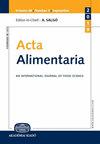双乳液溶剂蒸发法微胶囊化条件对蜂胶酚类化合物及抗氧化活性的影响
IF 1
4区 农林科学
Q4 FOOD SCIENCE & TECHNOLOGY
引用次数: 0
摘要
摘要以聚己内酯为壁材,采用双乳液溶剂蒸发(w1 /o/ w2)对蜂胶酚类化合物进行微胶囊化。通过微胶囊化实验,考察了样品/溶剂比(10 ~ 100 mg mL−1)、聚ε-己内酯(PCL)浓度(200 ~ 1000 mg mL−1)、聚乙烯醇(PVA)浓度(0.5 ~ 2.5 g mL−1)和搅拌速度(200 ~ 1000 r.p.m)对蜂胶总酚含量(TPC%)微胶囊化效率和抗氧化活性的影响。根据总酚含量和抗氧化活性选择最佳微胶囊化条件。实验结果表明,各微胶囊化条件均有显著影响(P <0.05)对总酚含量和抗氧化活性的影响。样品/溶剂比、PCL浓度、PVA浓度和搅拌速度分别为30 mg mL−1、600 mg mL−1、2 g mL−1和400 rpm时,酚包封效率为86.98±0.03%,自由基清除能力(DPPH)为53.81±0.50%,铁还原抗氧化能力(FRAP)为45480 Trolox当量,mg TE/100 g干重。在所有包封条件下,铁的抗氧化能力、自由基清除能力与酚类物质含量呈显著正相关。本文章由计算机程序翻译,如有差异,请以英文原文为准。
Effect of microencapsulation conditions on phenolic compounds and antioxidant activity of propolis using double emulsion solvent evaporation approach
Abstract The aim of this work was to microencapsulate propolis phenolic compounds using polycaprolactone as wall material by double emulsion solvent evaporation (w 1 /o/w 2) . Microencapsulation experiments were carried out by investigating the effect of sample/solvent ratio (10–100 mg mL −1 ), poly(ε-caprolactone) (PCL) concentrations (200–1,000 mg mL −1 ), poly(vinyl alcohol) (PVA) concentrations (0.5–2.5 g mL −1 ), and stirring speed (200–1,000 r.p.m.) on the microencapsulation efficiency of total phenolic content (TPC%) and antioxidant activity of propolis. The best microencapsulation conditions were selected according to the total phenolic amount and their antioxidant activity. Experimental results showed that all microencapsulation conditions had significant effects ( P < 0.05) on total phenolic content and antioxidant activities. The best conditions were: 30 mg mL −1 , 600 mg mL −1 , 2 g mL −1 , and 400 r.p.m. for sample/solvent ratio, PCL concentrations, PVA concentrations, and stirring speed, respectively, with values of 86.98 ± 0.03% for phenolic encapsulation efficiency, 53.81 ± 0.50% for free radical scavenging activity (DPPH), and 45,480 Trolox equivalent, mg TE/100 g dry weight for ferric reducing antioxidant power (FRAP). Under all encapsulation conditions, a significant positive correlation was observed between ferric reducing antioxidant power, free radical scavenging activity, and phenolic content.
求助全文
通过发布文献求助,成功后即可免费获取论文全文。
去求助
来源期刊

Acta Alimentaria
农林科学-食品科技
CiteScore
1.80
自引率
0.00%
发文量
47
审稿时长
18-36 weeks
期刊介绍:
Acta Alimentaria publishes original papers and reviews on food science (physics, physical chemistry, chemistry, analysis, biology, microbiology, enzymology, engineering, instrumentation, automation and economics of foods, food production and food technology, food quality, post-harvest treatments, food safety and nutrition).
 求助内容:
求助内容: 应助结果提醒方式:
应助结果提醒方式:


